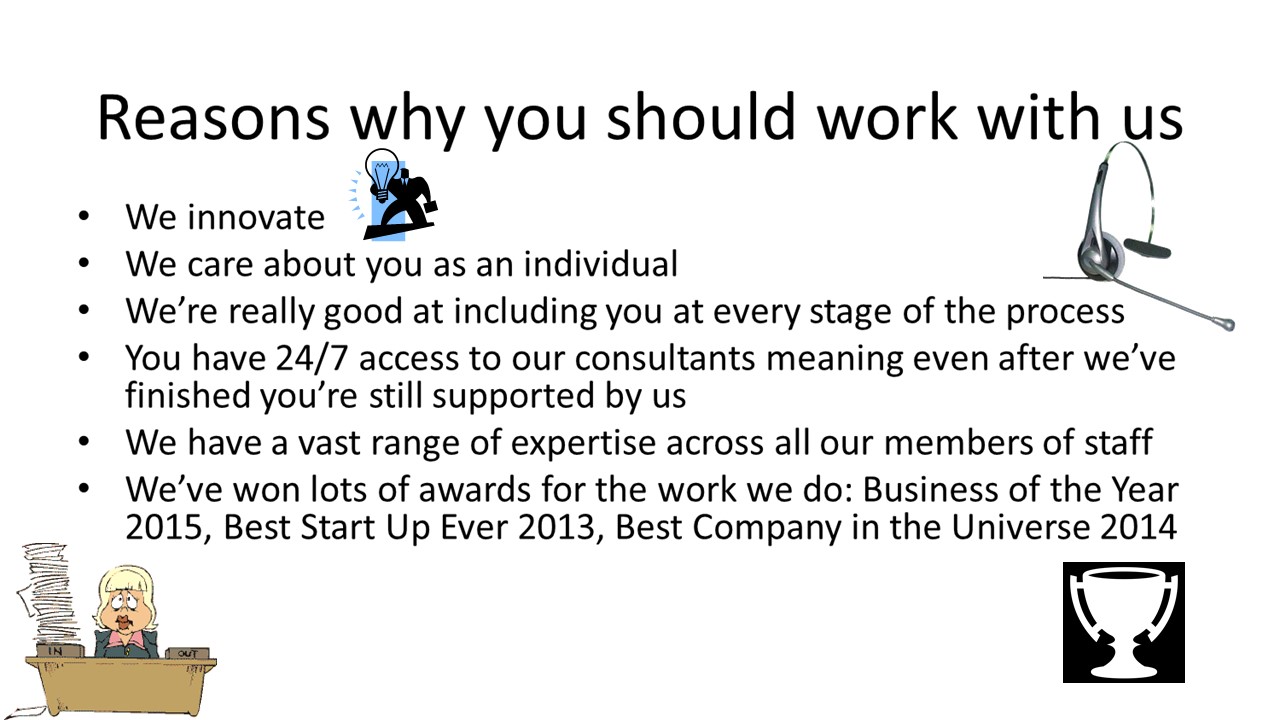How to create PowerPoint templates that work
Without a proper PowerPoint template, presentations can be a bit of a mess. Here are the building blocks for developing a PowerPoint template that works!
Office 365 keeps updating and every few weeks we notice a few new features. Sometimes it’s small things, but sometimes they’re pretty significant updates, and, as always with Microsoft, hidden away. This update features icons, with a selection of PowerPoint icons for presentations now built into PowerPoint itself.
You could think of it as ClipArt 2: The Icon Rises, I suppose, as there’s potential for this to become the fodder for badly designed slides with loads of things thrown in there. But when used correctly, icons are great to help you create clear, well designed slides.
Watch the video below for a detailed how-to, or read the article below for more hints and tips!
How does it work? Well, head on over to the Insert tab on the ribbon where you’ll now find the Icons button, between Shapes and 3D Models. Click that and you’ll be shown a whole load of icons that you can choose from.
The list of icons is fairly extensive, with categories of icons for people, technology and electronics, communication, business, analytics, commerce, education, arts, celebration, faces, signs and symbols, arrows, interface, nature and outdoors, animals, food and drinks, weather and seasons, location, vehicles, buildings, sports, security and justice, medical, tools and building, home, and apparel. So you’ll probably find something useful in there.
Once you’ve chosen your icon, rather excitingly, a new tab appears! I do love a new tab. This one’s called Graphic Tools Format. Sadly, there’s not actually much to get excited about. Mostly, it’s the same formatting choices that you have for any PowerPoint shape, with colours, and effects. Interestingly (to me at least) PowerPoint seems to be treating icons as a mix of standard shapes (things like changing the fill colours and line colours, and altering the graphic effects), but also images, as there is an option to change the graphic for another one in the library or another file, just like you can with pictures. And you can crop graphics, like you can with images (but not with shapes). You can also convert your icon into PowerPoint shapes, but as the majority of PowerPoint icons in the library are either a single shape, or possibly two, there’s not much advantage to doing so. And other than these few categorization quirks, there’s nothing really new.
It seems straightforward, but with icons, you can have a big impact on your slides. Let’s take this as an example:

Pretty terrible really. But sadly, a typical slide that’s abusing audiences all over the world. There are three quick design tips you can use to make this significantly better. We’ve gone into detail about it here, but for loyal Carbonites who already know and love that post, to summarize the points:

Previously, finding PowerPoint icons to do this could be a bit of a drag, but now, you can easily find the right icon for the job.
What’s more, if you go to any of the many stock icon libraries, such as Creative Market, Flat Icon, The Noun Project, and Illustrio, you can download plenty of free PowerPoint icons and other graphics to choose from (and even more premium ones for a modest fee). Typically, you’ll find them in SVG formats (or Scalable Vector Graphics), which were somewhat difficult to deal with previously. Now, find the icon sets that you like, drag the relevant SVG icon file into PowerPoint, and use the same Graphics Tools Format tab to open up these files as editable PowerPoint icons.
If you don’t have Office 365, then sorry, these functions aren’t available. But I happen to know a great presentation design agency that would be delighted to help you create beautiful and effective visual presentation content. And there’s loads of free PowerPoint stuff for you at our resources page too. So all is not lost, and you can still make some great slides.
There are other options if you have PowerPoint 2013. You could use an icon font, type out all the characters, then copy the text box, and using Paste Special on the Home tab, paste them as a Picture (Enhance Metafile). Then draw a box around the pasted icons, select both and in the Format tab, under Merge Shapes, choose Fragment. This will break everything up into it’s individual components and give you editable PowerPoint icons.
Or for everyone else, vector graphics in EMF format should work by dragging them into PowerPoint, then choosing to ungroup once (Ctrl + Shift + G), to convert it into a Microsoft drawing object, and then ungrouping again to actually break it apart. You’ll probably need to do a bit of formatting to tidy things up though, and, to be honest, it’s often tricky to find online resources that give you EMF files. Up until 2017 it was easier, but Microsoft updated PowerPoint to no longer accept EPS files – another common form of vector files – due to security concerns. Another option is just to use images instead. Many of the sites give you transparent background PNG files to download, and with most of the sites suggested above, you can change the colour and style of the icon before downloading it, so that may be the best option. Or, take the opportunity to update to Office 365 (Microsoft’s cunning plan all along). In the meantime, check out the free PowerPoint icons we have in our awesome presentation toolkit.
Leave a comment
Without a proper PowerPoint template, presentations can be a bit of a mess. Here are the building blocks for developing a PowerPoint template that works!
By applying some key principles of presentation design, you can make your PowerPoint design really standout and deliver both a more ‘popping’, but also more effective presentation.
Most presentations are a cascade of text-heavy Death-by-PowerPoint slides. Online learners suffer the torture of brochures converted to click-through-eLearning. Most people now recognize that using visuals is the way to go. But how do you make visual presentations and eLearning that work? We think there are six steps you need to follow.
Join the BrightCarbon mailing list for monthly invites and resources
Tell me more!I absolutely love this, thank you so much. I have shared your fabulous resources with many folks. Thanks for all the brilliant work you do!
Michaela Butterworth State of Kansas

Thanks for your words on icons in PowerPoint.
I noticed that you suggested putting a picture in as background for the example slide.
I don’t understand why various people making that kind of decision think that some out-of-focus picture will enhance the presentation. When I see that my eyes work overtime trying to get the view in focus to no avail.
What’s worse is the news broadcasts which want to show someone’s phone video (portrait mode) with the other two-thirds of the screen an out-of-focus version of what is the subject. Again eyes working overtime trying to get everything in focus.
Hi James,
Very good points, and totally with you on video, which is really distracting as it’s moving/changing. For images, maybe there’s a case. In this instance, we’re suggesting having the image, then blurring it back, so it obviously becomes the background, and leaves the content on top. As you’re animating things in a sequence and not just looking at a full static all appearing at once, you can take your audience through the elements, so they focus most attention on the content itself. Blurring the image certainly helps so that they’re less likely to go back to looking a the image.
The reason for doing it is to add a graphic richness to the slide that’s easy to do. Other ways often require a level of design skill (that I certainly don’t have) that will either look poor if badly executed, or take a lot more time. Many companies also have imagery as a big part of their brand style, so you often see loads of images in different template layouts that people are supposed to use – this helps get away from more distracting in-focus images.
But ultimately, yes, you’re right, this does have the potential to be distracting. We’ve tried to minimize it with animation timing and blur. For many, it’s a balance between that risk, and a presentation that looks drab and so not impressive for your audience.
Great comment and observation, thank you!